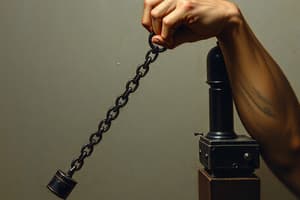Podcast
Questions and Answers
What is a first-class lever?
What is a first-class lever?
- No mechanical advantage
- Resistance in the middle
- Axis in the middle, like a see-saw (correct)
- Effort in the middle
What is the most versatile lever because it can be used for any type of mechanical advantage?
What is the most versatile lever because it can be used for any type of mechanical advantage?
first
What characterizes a second-class lever?
What characterizes a second-class lever?
Resistance in the middle
What is a third-class lever?
What is a third-class lever?
What type of lever arrangement is most common in musculoskeletal systems?
What type of lever arrangement is most common in musculoskeletal systems?
What type of lever is a bicep curl?
What type of lever is a bicep curl?
What type of lever is a push up?
What type of lever is a push up?
What examples demonstrate a first-class lever?
What examples demonstrate a first-class lever?
Flashcards
First-Class Lever
First-Class Lever
Axis (fulcrum) is positioned between the effort and the resistance (load).
Most versatile lever
Most versatile lever
A first-class lever. It allows for all types of mechanical advantage depending on the placement of the axis.
Second-Class Lever
Second-Class Lever
Resistance (load) is positioned between the axis (fulcrum) and the effort.
Third-Class Lever
Third-Class Lever
Signup and view all the flashcards
Lever in musculoskeletal system
Lever in musculoskeletal system
Signup and view all the flashcards
Bicep Curl Lever Class
Bicep Curl Lever Class
Signup and view all the flashcards
Push-Up Lever Class
Push-Up Lever Class
Signup and view all the flashcards
Examples of First-Class Levers
Examples of First-Class Levers
Signup and view all the flashcards
Study Notes
Classes of Levers
-
1st Class Lever:
- Axis is positioned in the middle between effort and resistance.
- Example: See-saw.
- In the body, pushing down on a gas pedal and elbow/triceps extensions overhead demonstrate this leverage.
-
Versatile Lever:
- 1st class lever is the most adaptable as it can provide any type of mechanical advantage.
-
2nd Class Lever:
- Resistance is located in the middle, providing a force advantage for effort.
- Example: Push-up where the body acts as the lever, feet serve as the axis, and the body's weight is the resistance.
-
3rd Class Lever:
- Effort is situated in the middle, with muscle acting as the effort force.
- Offers advantages in range of motion (ROM) and speed, but has a disadvantage in force output.
-
Common Musculoskeletal Arrangements:
- Most are classified as 3rd class levers.
-
Bicep Curl Example:
- Illustrates a third class lever configuration.
-
Push Up Example:
- Serves as a practical example of a 2nd class lever.
-
Additional 1st Class Lever Example:
- Includes actions like pushing down on a gas pedal or performing elbow/triceps extensions overhead.
Studying That Suits You
Use AI to generate personalized quizzes and flashcards to suit your learning preferences.




